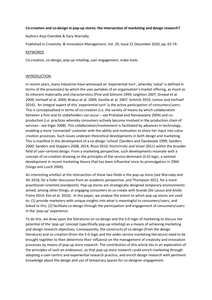In this paper we explore the influence of the physical and social environment (the design space) son the formation of shared understanding in multidisciplinary design teams. We concentrate on the creative design meeting as a microenvironment for studying processes of design communication. Our applied research context entails the design of mixed physical–digital interactive systems supporting design meetings. Informed by theories of embodiment that have recently gained interest in cognitive science, we focus on the role of interactive “traces,” representational artifacts both created and used by participants as scaffolds for creating shared understanding. Our research through design approach resulted in two prototypes that form two concrete proposals of how the environment may scaffold shared understanding in design meetings. In several user studies we observed users working with our systems in natural contexts. Our analysis reveals how an ensemble of ongoing social as well as physical interactions, scaffolded by the interactive environment, grounds the formation of shared understanding in teams. We discuss implications for designing collaborative tools and for design communication theory in general.
MULTIFILE

There has probably never been such an intense debate about the layout of the countryside as the one that is currently raging. There are serious concerns about the landscape, which is being rapidly transformed by urbanization and everything associated with this process, and not only in the Netherlands but also far beyond its borders. Everyone has something to say in this society-wide debate, from local to national governments, from environmental factions to the road-user's lobby, and from those who are professionally involved to concerned private parties. In many cases it is a battle between idealized images and economic models, between agricultural reality and urban park landscapes, between ecological concerns and mobility. This issue of OASE explores the potential significance of architectonic design for transformation processes on the regional scale. Besides considering the instruments that are available to the designer to fulfil this task, the authors also consider how the design can exercise a 'positive' influence on such processes. The various contributions shed light on the potential significance of territory in contemporary design practice and offer critical reflection on the topical discourse that has evolved over recent years.
DOCUMENT

Co-creation as a concept and process has been prominent in both marketing and design research over the past ten years. Referring respectively to the active collaboration of firms with their stakeholders in value creation, or to the participation of design users in the design research process, there has arguably been little common discourse between these academic disciplines. This article seeks to redress this deficiency by connecting marketing and design research together—and particularly the concepts of co-creation and co-design—to advance theory and broaden the scope of applied research into the topic. It does this by elaborating the notion of the pop-up store as temporary place of consumer/user engagement, to build common ground for theory and experimentation in terms of allowing marketers insight into what is meaningful to consumers and in terms of facilitating co-design. The article describes two case studies, which outline how this can occur and concludes by proposing principles and an agenda for future marketing/design pop-up research. This is the peer reviewed version of the following article: Overdiek A. & Warnaby G. (2020), "Co-creation and co-design in pop-up stores: the intersection of marketing and design research?", Creativity & Innovation Management, Vol. 29, Issue S1, pp. 63-74, which has been published in final form at https://doi.org/10.1111/caim.12373. This article may be used for non-commercial purposes in accordance with Wiley Terms and Conditions for Use of Self-Archived Versions. LinkedIn: https://nl.linkedin.com/in/overdiek12345
MULTIFILE

Society continues to place an exaggerated emphasis on women's skins, judging the value of lives lived within, by the colour and condition of these surfaces. This artistic research will explore how the skin of a painting might unpack this site of judgement, highlight its objectification, and offer women alternative visualizations of their own sense of embodiment. This speculative renovation of traditional concepts of portrayal will explore how painting, as an aesthetic body whose material skin is both its surface and its inner content (its representations) can help us imagine our portrayal in a different way, focusing, not on what we look like to others, but on how we sense, touch, and experience. How might we visualise skin from its ghostly inner side? This feminist enquiry will unfold alongside archival research on The Ten Largest (1906-07), a painting series by Swedish Modernist Hilma af Klint. Initial findings suggest the artist was mapping traditional clothing designs into a spectral, painterly idea of a body in time. Fundamental methods research, and access to newly available Af Klint archives, will expand upon these roots in maps and women’s craft practices and explore them as political acts, linked to Swedish Life Reform, and knowingly sidestepping a non-inclusive art history. Blending archival study with a contemporary practice informed by eco-feminism is an approach to artistic research that re-vivifies an historical paradigm that seems remote today, but which may offer a new understanding of the past that allows us to also re-think our present. This mutuality, and Af Klint’s rhizomatic approach to image-making, will therefore also inform the pedagogical development of a Methods Research programme, as part of this post-doc. This will extend across MA and PhD study, and be further enriched by pedagogy research at Cal-Arts, Los Angeles, and Konstfack, Stockholm.